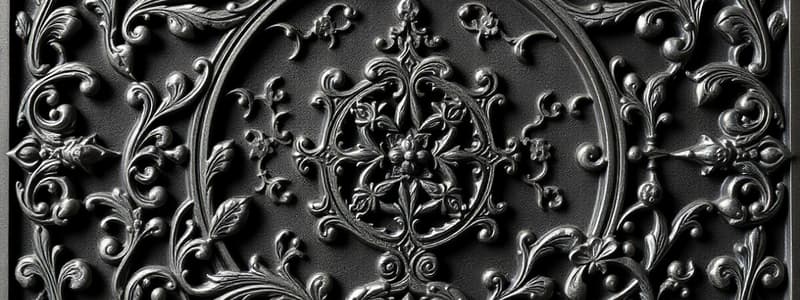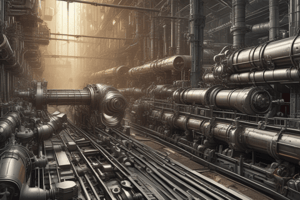Podcast
Questions and Answers
What is the purpose of the sintering process in powder metallurgy?
What is the purpose of the sintering process in powder metallurgy?
- To blend different elemental powders
- To bind, densify, and strengthen the compact (correct)
- To create the initial powder particles
- To produce high-temperature molds
Which of the following describes a method used in compaction within powder metallurgy?
Which of the following describes a method used in compaction within powder metallurgy?
- Chemical reactions to create particle bonds
- Liquid metal casting techniques
- Heating the powder to high temperatures
- Injecting the powder into molds under pressure (correct)
What is a critical factor in the production sequence of powder metallurgy?
What is a critical factor in the production sequence of powder metallurgy?
- Use of high-speed machining to finish parts
- Controlled heating during the sintering process (correct)
- Addition of molten metal during compaction
- Direct forging of the final product
Which component is NOT typically made using powder metallurgy?
Which component is NOT typically made using powder metallurgy?
What is one of the advantages of using powder metallurgy for producing parts?
What is one of the advantages of using powder metallurgy for producing parts?
What are the mechanical properties of parts produced through Powder Metal Injection Molding (PMIM) compared to wrought products?
What are the mechanical properties of parts produced through Powder Metal Injection Molding (PMIM) compared to wrought products?
Which step directly follows the compacting of the part in the PMIM process?
Which step directly follows the compacting of the part in the PMIM process?
What is the primary purpose of the sintering process in Powder Metallurgy?
What is the primary purpose of the sintering process in Powder Metallurgy?
Which compaction technique applies pressure using a high-pressure fluid and combines sintering with compaction?
Which compaction technique applies pressure using a high-pressure fluid and combines sintering with compaction?
What type of metal powders are typically used in Powder Metal Injection Molding?
What type of metal powders are typically used in Powder Metal Injection Molding?
In comparison to Hot Isostatic Pressing (HIP), what is a key characteristic of Cold Isostatic Pressing (CIP)?
In comparison to Hot Isostatic Pressing (HIP), what is a key characteristic of Cold Isostatic Pressing (CIP)?
Which application is NOT commonly associated with the use of Powder Metal Injection Molding?
Which application is NOT commonly associated with the use of Powder Metal Injection Molding?
What does the term 'green compact' refer to in the context of Powder Metallurgy?
What does the term 'green compact' refer to in the context of Powder Metallurgy?
What is the first step in the production of powder-metallurgy parts?
What is the first step in the production of powder-metallurgy parts?
Which method is characterized by powder being placed in a flexible mold and pressurized hydrostatically?
Which method is characterized by powder being placed in a flexible mold and pressurized hydrostatically?
What temperature range is typically used in the Powder-Injection Molding process?
What temperature range is typically used in the Powder-Injection Molding process?
In wet-bag Cold Isostatic Pressing, what is done to the mold before immersion into the pressure medium?
In wet-bag Cold Isostatic Pressing, what is done to the mold before immersion into the pressure medium?
What is the purpose of sintering in the powder metallurgy process?
What is the purpose of sintering in the powder metallurgy process?
Which compaction method combines sintering with the compaction operation due to elevated temperatures?
Which compaction method combines sintering with the compaction operation due to elevated temperatures?
What is a characteristic feature of the dry-bag technique in Cold Isostatic Pressing?
What is a characteristic feature of the dry-bag technique in Cold Isostatic Pressing?
What is metal injection molding primarily used for?
What is metal injection molding primarily used for?
Flashcards
Powder Metal Injection Molding (PMIM)
Powder Metal Injection Molding (PMIM)
A process for creating small, complex metal parts by mixing metal powder with binders, compacting the mixture, removing the binder, and then sintering the remaining metal.
Atomization
Atomization
The process of breaking a liquid metal stream into small particles using jets of gas, air, or water.
Comminution
Comminution
Crushing or grinding brittle metals into small particles.
Green Compact
Green Compact
Signup and view all the flashcards
Green Strength
Green Strength
Signup and view all the flashcards
Hot Isostatic Pressing (HIP)
Hot Isostatic Pressing (HIP)
Signup and view all the flashcards
Cold Isostatic Pressing (CIP)
Cold Isostatic Pressing (CIP)
Signup and view all the flashcards
Sintering
Sintering
Signup and view all the flashcards
PMIM Advantages
PMIM Advantages
Signup and view all the flashcards
Powder Metallurgy Production Steps
Powder Metallurgy Production Steps
Signup and view all the flashcards
Powder Production
Powder Production
Signup and view all the flashcards
Powder Blending
Powder Blending
Signup and view all the flashcards
Compaction (Consolidation)
Compaction (Consolidation)
Signup and view all the flashcards
Sintering
Sintering
Signup and view all the flashcards
Finishing Operations
Finishing Operations
Signup and view all the flashcards
Cold Isostatic Pressing (CIP)
Cold Isostatic Pressing (CIP)
Signup and view all the flashcards
Hot Isostatic Pressing (HIP)
Hot Isostatic Pressing (HIP)
Signup and view all the flashcards
Powder Injection Molding (MIM)
Powder Injection Molding (MIM)
Signup and view all the flashcards
Wet-Bag CIP
Wet-Bag CIP
Signup and view all the flashcards
Dry-Bag CIP
Dry-Bag CIP
Signup and view all the flashcards
Roll Densification
Roll Densification
Signup and view all the flashcards
Powder Metallurgy
Powder Metallurgy
Signup and view all the flashcards
Powder Stage
Powder Stage
Signup and view all the flashcards
Green Structure
Green Structure
Signup and view all the flashcards
Consolidation/Compaction
Consolidation/Compaction
Signup and view all the flashcards
Sintering
Sintering
Signup and view all the flashcards
Finishing Operations
Finishing Operations
Signup and view all the flashcards
Powder Metallurgy Applications
Powder Metallurgy Applications
Signup and view all the flashcards
Study Notes
Powder Metallurgy
- Powder metallurgy is a metal forming and fabrication technique that competes with casting, forging, and machining.
- It involves three major stages:
- Dividing a primary material into small particles (powder)
- Injecting the powder into a mold or passing it through a die to create a green structure (a structure similar to the final product's shape but not yet fully solidified or strong).
- Forming the final part by applying pressure, high temperatures, and long-setting times (during which the part self-welds).
Powder Metallurgy Applications
- Solid parts like gears, cams, bushings, and rotors.
- Porous parts like Oilite bushings and filter elements.
- Taps and dies for cutting threads.
- Tungsten carbide ball-point pen balls.
- Piston rings and brake pads.
- Surgical instruments and implants.
Powder Metallurgy Advantages/Disadvantages
- Advantages:
- Competition with forging and casting.
- Wide variety of net and near-net shapes.
- Controlled porosity or nearly full density.
- Useful for refractory alloys.
- High production rates.
- Wide range of material properties and specialty alloys.
- Disadvantages:
- Metal powder sometimes dangerously explosive.
- Specialized metal powder can be expensive.
- Density inconsistency can occur in the finished product.
- Expensive tooling and equipment.
- Large parts not feasible.
- Parts are not as strong as forgings (but some P/M parts can be forged).
Typical Sequence for Powder Part Production
- Production of powder (elemental particles or pre-alloyed particles).
- Blending of the powder, especially elemental powders. This step may include the addition of binder particles for metal injection molding.
- Compaction (consolidation) to form a compact (green compact).
- Sintering (heating at a controlled, sub-melting temperature) to bind, densify, and strengthen the compact.
- Finishing operations (re-pressing, forging, sealing, plating, etc.).
Powder Production Methods
- Atomization: Molten metal sprayed into a jet of water or argon.
- Reduction: Chemical removal of oxygen from metal oxides.
- Pulverizing: Crushing metal in a ball mill.
Consolidation by Pressing
- Similar to forging.
- Typically done at room temperature.
- High pressures are needed.
- Density increase by varying particle sizes and applying high pressure.
Density & Mechanical Properties
- Density of the powder product significantly influences its mechanical properties.
- Compacting pressure affects the density.
- Higher density results in better mechanical properties.
Isostatic Pressing
- Compaction by applying pressure in all directions.
- More uniform compaction.
- Improved mechanical properties.
- Reduced density variations.
Cold Isostatic Pressing (CIP)
- Uses pressurized fluid (typically water).
- Followed by sintering.
- Powder part isolated from the pressurized fluid using a mold.
Hot Isostatic Pressing (HIP)
- Uses pressurized fluid (typically argon).
- Combines compaction and sintering.
- High pressure and temperature for improved density and properties.
- Heating provided by resistive heating coils within a pressure vessel.
Sintering
- Heating the green compact at a controlled temperature in a controlled atmosphere.
- Sintering temperature is below the melting point of the metal.
- Diffusion occurs during sintering to produce bonding and densification.
Powder Metal Injection Molding (MIM)
- Suitable for small, complex parts.
- Metal powder mixed with binders (polymers or wax).
- Powder mixture injected into a mold.
- Steps include debinding or debinding, followed by sintering.
- Advantages include high production rate, close tolerances, and complex shapes.
Powder Metallurgy Definitions
- Atomization: Liquid metal stream, broken by inert gas, air, or water jets.
Mechanical & Physical Properties (depending on Density)
- Mechanical properties rely on their density to increase metal particle contact.
- Improved cohesion results in greater strength, ductility, elastic modulus, and toughness.
Studying That Suits You
Use AI to generate personalized quizzes and flashcards to suit your learning preferences.




